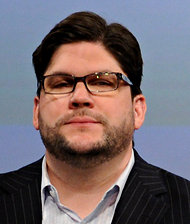 Peter Kramer/NBC Jim Bell, the executive producer of the “Today” show.
Peter Kramer/NBC Jim Bell, the executive producer of the “Today” show.
8:24 p.m. | Updated
For the first time since removing Ann Curry from “Today” on NBC, the show’s executive producer on Wednesday defended that decision and sought to define the cause of its recent ratings setbacks, including the end of its 16-year weekly winning streak.
The producer, Jim Bell, said it “was absolutely my call” to replace Ms. Curry as co-anchor of the “Today” show in June after only a year on the job. While “Today” lost its longstanding lead over ABC’s “Good Morning America” in April, before Ms. Curry was ousted, its ratings have continued to erode since her departure.
“GMA” has won the last six weeks by margins ranging from 255,000 viewers to 883,000. It has also beaten “Today” by increasingly sizable margins in the category most important to advertisers, viewers ages 25 to 54. Last week, “GMA” won that group by 234,000 viewers, its biggest edge since it took over first place.
In a telephone interview, Mr. Bell offered numerous reasons that “GMA” had taken over as the regular leader in the morning news competition, including the sheer difficulty of maintaining dominance for so long. But he pointed in particular to what he called the difference in the show’s approaches, calling “Today” a “more serious show” and accusing “GMA” of “doing something else.”
Asked if he was suggesting “GMA” was now a tabloid-style program, Mr. Bell said, “That’s what I’m saying.”
ABC News on Wednesday responded by first pointing to the scoreboard. “I think the audience has spoken loud and clear about its preference in the morning,” said Julie Townsend, spokeswoman for ABC News.
ABC executives were also eager to note that such a description could be applied to a recent “Today” interview with Kris Jenner, mother of television’s most popular tabloid family, the Kardashians, about her breast implants. (That interview drew attention because it came when the other morning news programs were observing a moment of silence for the victims of the Sept. 11 attacks.)
Mr. Bell declined to call the original choice of Ms. Curry to succeed Meredith Vieira a mistake — “Ann had earned it,” he said — but he noted that Ms. Curry is now “in the role she is naturally suited for.” (Ms. Curry is now a special correspondent for the show, reporting, so far, mostly on international news; on Wednesday, she interviewed Libya’s interim president, Mohammed Magarief.)
Mr. Bell defended the appointment of Savannah Guthrie as the co-anchor beside Matt Lauer, calling her an important part of a “long view” plan for “Today” to regain the top ratings position. He specifically denied recent reports that the decision to remove Ms. Curry was a response to demands by Mr. Lauer, who recently renegotiated his contract.
“It was definitely not Matt’s call,” Mr. Bell said. “He is the host and does not have management responsibility. It was not his call. That was my call.”
Mr. Bell also expressed incredulity at recent reports that Mr. Lauer had been more vocal in his demands about the show, and had begun berating staff members. “These stories portraying Matt in a negative light are just preposterous,” Mr. Bell said. “Matt is the heart and soul of the broadcast. He has a heart of gold. This stuff about him has been very irresponsible and in a lot of cases flat-out wrong.”
Nor is “Today” facing any budget cuts to compensate for paying Mr. Lauer a reported $25 million a year, Mr. Bell said. “There is no plan for any cutbacks of layoffs for any of the staff,” he said. As for any reduction to Mr. Lauer’s salary, which was reported in The Daily News this week, “that could not be more wrong,” Mr. Bell said.
Asked what viewers could expect in the way of changes to affect this long-view approach, Mr. Bell said, “You just have to watch.”
Bill Carter writes about the television industry. Follow @wjcarter on Twitter.
Article source: http://mediadecoder.blogs.nytimes.com/2012/09/26/executive-producer-of-today-says-ouster-of-ann-curry-was-his-call/?partner=rss&emc=rss